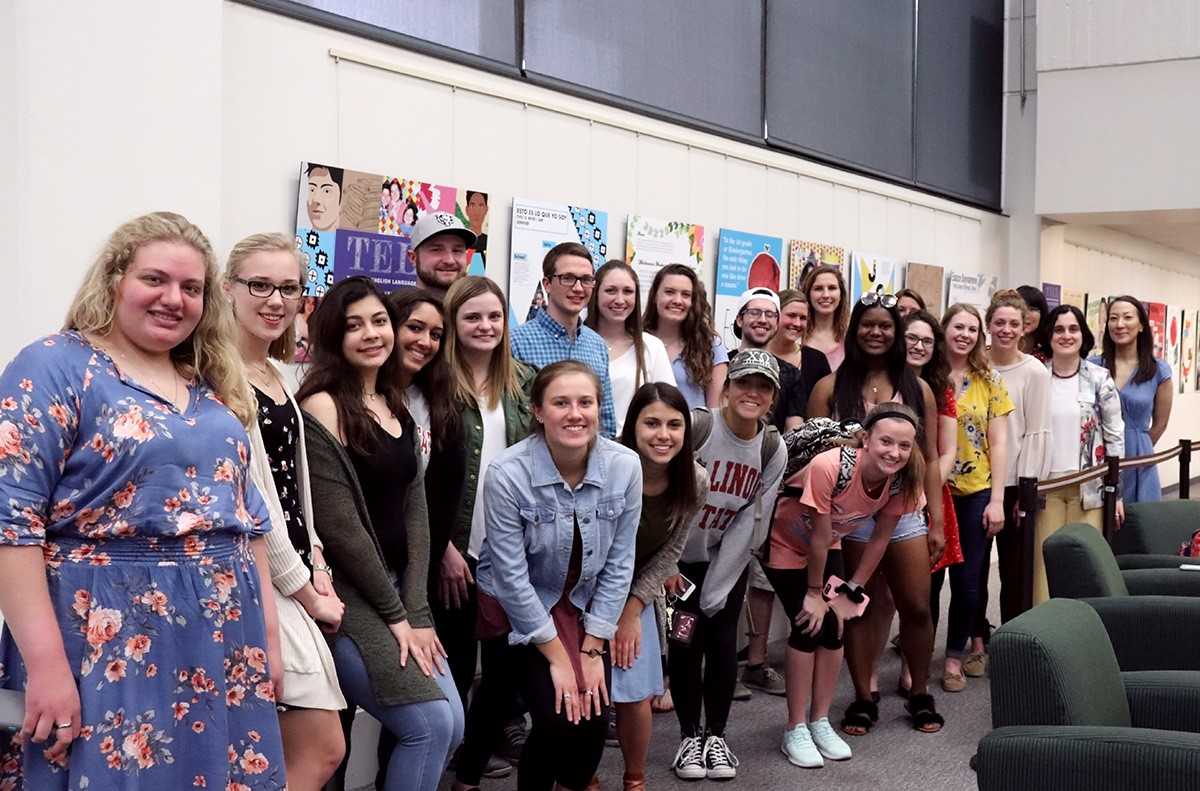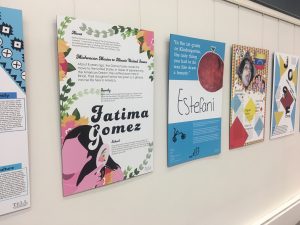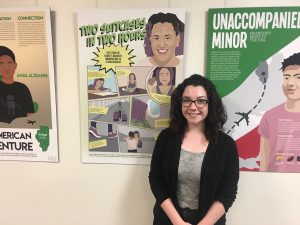An eye-catching exhibit in Milner Library is a perfect synthesis of interdisciplinary collaboration and civic engagement.
Milner Library held the opening reception for TELL (Tales of English Language Learners) on April 12. TELL is an exhibit created collaboratively by teaching and learning and graphic design students. The displays express the challenges, stories, and cultural traditions of English language learners (ELLs) in Bloomington-Normal.
The project is a collaboration between the classes of Rabia Hos, assistant professor in bilingual education, and Alice J. Lee, assistant professor of graphic design. Last fall, Hos had the idea of highlighting the stories of ELLs in the area through an exhibition in Milner. She approached Kathleen Lonbom, chair of Milner Library’s Exhibits Committee, about whom she should partner with.
“Alice’s students had an exhibit that was being displayed at the time Rabia told me about her idea,” Lonbom said. “I thought she would be the perfect fit for what she was trying to accomplish.”
Lee said when she was approached about doing the project, she didn’t think twice about moving forward.
“I am always looking for opportunities to show my students that it is possible to do graphic design work that isn’t based solely on commerce,” she said. “When I was told about this idea, I jumped onboard.”
Hos put her students in contact with ELLs in Bloomington-Normal schools and at Illinois State. Once interviews were conducted, Hos’ students took that information to Lee’s design students. From there, the students collaborated on a design they felt best expressed that ELL’s story.
Hos says that reaching out to ELLs in the community was designed to help her students be better, more compassionate teachers and learners.
“It was a really eye-opening experience for a lot of my students that have never met an English Language Learner,” Hos said. “We teach a lot of theories about how to support these students, but this was a real experience where they got to speak to these students. They got to learn about their backstories and tap into their strengths.”
Sophomore elementary education major Madeleine Ferguson said being able to speak with ELLs helped her better understand the unique challenges these students face in the classroom.
“It is easy as an educator to think of the student as just a student,” Ferguson said. “But this experience helped me understand deeply that every student is bringing something from their home life to the classroom.”
In the design process, Lee urged her students to create works that were unique to the subjects, but also visually diverse.
“We did a lot of critiques and worked with each other to tell these stories in a visual and respectful way,” Lee said. “A lot of the conversations we had were about what kind of visual symbols would be used to represent these stories and trying to stay away from cliches.”
Ferguson said this level of collaboration with the designers allowed them to tell the best version of their subject’s story.
“These posters are designed to catch the eye of people passing by, not be an entire novel,” she said. “We started off with a lot of information but were able to really taper down into what we felt was truly important.”
Junior graphic design student Cara Shapkauski collaborated on a piece about a 13-year-old girl from Honduras named Kensy.
“She knew nothing about the U.S. when she got here,” Shapkauski said. “She didn’t know the language or have any kind of cultural references to help her navigate her new life.”
Shapkauski said it would be easy to dwell on the darker portions of Kensy’s story, but felt it was more important to show her bravery. Shapkauski created a design that took inspiration from American superhero comics.
“I didn’t necessarily want to put her in a cape or reference a known superhero, but I wanted something that shows she is the hero of her story,” Shapkauski said.
The exhibit will be on the second floor of Milner Library through May 12. Interim Dean of Milner Library Shari Zeck said there is always a place for exhibits like TELL in Milner.
“We like to be a place where people come to learn in different ways,” Zeck said. “There are a lot of kinds of traditional research that people do, but people also learn visually, by talking to people different from them. This exhibit is a perfect representation of that.”
Tyler Emken can be reached at tkemken@IllinoisState.edu.



